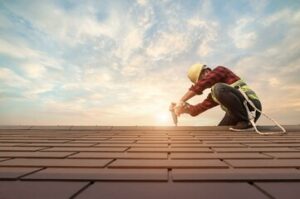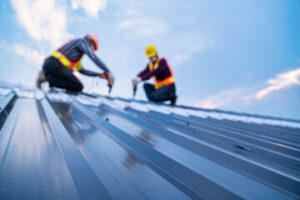Regular inspections and maintenance extend the lifespan of your roof, saving you money in the long run. This includes cleaning gutters, examining the flashing, and inspecting the sealant.

Identifying signs of damage can help you decide whether repairs are appropriate. However, if the damage is significant and your roof is nearing its expected lifespan, it may be time to replace it. Keep reading the article below to Get a Free Quote Today.
The shingles on your roof provide the first line of defense against the elements. When they are damaged or destroyed, water can seep into the home and cause structural damage and other problems. Performing routine inspections of your shingle roof can help you spot problems before they become serious.
Visible signs of roof damage include cracks, blistering, bubbling, fading or granule loss. These problems indicate that the shingles are losing their protective ability due to weather conditions, age or general wear and tear. Keeping up with these repairs will help extend the life of your roof and avoid costly repair bills down the road.
Shingles should overlap each other and be securely attached to the underlying decking. If a shingle is loose or missing, it should be replaced to prevent leaks and other problems. Also look for dark spots or streaks on shingles, which are an indication of mold and mildew growth.
Heavy winds and hail can severely damage shingle roofs, resulting in a number of visible problems including shingle loosening or damage. Also look for shingles that are curled upward, which is a sign of damage and can expose the home to water leaks.
Check for cracked or peeling shingles that need to be replaced and check the integrity of the caulk around the flashing on your chimney, vent pipes or skylights. Also inspect for moss and lichen, which can weaken the shingle material.
A sagging roof can cause structural damage, which will require expensive repairs to your roof and other areas of the home. If the sagging is caused by a roof leak, the inspector will look for water stains and other signs of moisture in the attic.
Clean your gutters to prevent clogs that can lead to water damage, and inspect for ice dams in winter. Ensure that your attic insulation is adequate to avoid heat loss and monitor the condition of shingle flashing in the winter. Inspect for ice and snow damage, and be sure to trim nearby trees that hang over your roof. The eaves, soffit, fascia and the roof ridge are also areas to be examined for dry rot and other signs of decay.
Clean the Gutters
Taking the time to clean your gutters is an essential part of roof maintenance. Gutters that become clogged with leaves and debris won’t divert water away from your home, and standing water can stain or rust the gutters. Most experts recommend cleaning your gutters at least twice a year, and you should do so more often if you have overhanging trees or frequent storms.
You’ll want to start your gutter cleaning near the downspout and work your way backward, making sure to clear the clogs. Once you’re done with the eaves, don’t forget to inspect other higher areas like the soffits, fascia boards, and chimneys and flashing for signs of loose shingles or rot.
It’s best to clean your gutters with a ladder rather than from the ground. You should wear gloves and a face mask to protect yourself from the toxins. If you’re not comfortable working on a ladder, it’s worth hiring a professional to clean your gutters for you. In addition to being a safety precaution, professionals can help you keep up with regular gutter cleaning and inspection.
Clogged gutters can cause more damage than you might think. In addition to the obvious stains and water puddles, they can force water under the shingles, causing leaks in the attic or behind walls. They can also contribute to mold, mildew, and wood rot around the exterior of your house.
The eaves of your roof are designed to divert water away from the foundation and other parts of your home. However, if your gutters are clogged with leaves, sticks, and other debris, they won’t work properly. Instead, the water will build up in the eaves trough until it overflows or spills down the sides of your home or into the soffit and fascia.
The best way to prevent this is to clean your gutters regularly and install proper diverters to ensure water is always flowing away from your house. Gutters that are not cleaned can lead to wood rot and leaks in the attic, and gutters that are overflowing with debris can damage the foundation of your home.
Check the Flashing
Flashing is metal that runs along the edges of roofs, walls, chimneys, vents, skylights, and other penetrations in a roof to direct water away from the structure. It can be a source of leaks if it fails or is poorly installed. Flashing should be inspected at least once a year to identify and repair potential issues.
Look for missing pieces of flashing, cracks in the flashing or sealant, and signs of moisture intrusion. If you can safely access the area, a close examination is best. If a ladder isn’t available, a good view of the entire roof from a neighboring house or a window may help spot problems.
The most common issue is leaking. If you see stains or water marks on the ceiling or walls near the flashing area, this is a clear sign that the flashing has failed. You should also check the areas around the chimney, valleys, and other structural features to make sure they are well sealed and watertight.
Rust and corrosion are other indicators that flashing is failing. If the metal is rusty or showing signs of corrosion, it is time to replace that section of flashing. In addition, you should regularly remove debris like leaves, twigs, and branches that can trap moisture against the flashing.
Check the caulking that seals the flashing to ensure it is intact and still effective. If the caulk breaks, it can allow moisture to enter the roof system and cause damage. It is a good idea to have a professional inspect your roof and do the work if it needs to be done.
Roof maintenance can be a daunting task, but it is important to do it regularly. This helps keep the integrity of your roof and prevents major problems down the road. Using Modernize to find a local roofer can save you time and hassle and provide confidence that your project is done correctly. We will pair you with up to four pros in your area, allowing you to compare quotes and options before choosing the right roofing professional for your project.
Inspect the Sealant
While sealants are not a replacement for a well-maintained roof, they can help prevent water intrusion and other damage. As with shingles, it’s important to inspect the sealant regularly for signs of deterioration and failure, such as cracks or gaps. In addition to allowing moisture to infiltrate the home, these gaps can also allow pests to enter and cause further damage.
A professional can inspect your roof for damage and leaks and re-apply the sealant as necessary. They can use a variety of materials to seal the joints and cracks, including silicone and rubber. They can also apply the sealant in a manner that complies with the manufacturer’s recommendations, ensuring a strong and long-lasting bond.
It’s also a good idea to inspect other areas where the roof meets other components like chimneys and vents for signs of moisture infiltration. You can even examine the flashing around these areas for any cracks or gaps that need to be sealed. These spots are particularly susceptible to water leaks.
When re-sealing, it is recommended to test the new sealant on a small area before applying it to the entire joint. This helps ensure the proper adhesion and compatibility with the surface of the roof. If the new sealant isn’t compatible, it can result in a weak bond that could fail quickly.
Typically, the best time to apply sealant is during the construction of a new roof when the manufacturer’s specifications for sealing are followed. In addition, regular inspections of the roof and re-application of sealants can extend the life of the roof.
The best way to identify damaged or missing sealant is through a comprehensive roof inspection conducted by a qualified roofing contractor. They will be able to assess the condition of the entire roof, and address any problems right away to avoid costly repairs in the future. Ideally, these inspections should be scheduled at least once annually. However, some buildings and problematic areas may require more frequent inspections to extend the lifespan of the roof. Getting these inspections done by professionals will also save you from the danger and inconvenience of climbing on the roof.

